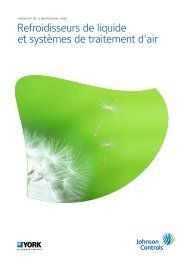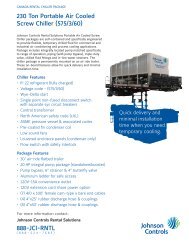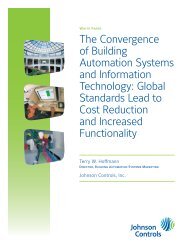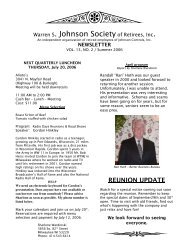Rxf - Johnson Controls Inc.
Rxf - Johnson Controls Inc.
Rxf - Johnson Controls Inc.
Create successful ePaper yourself
Turn your PDF publications into a flip-book with our unique Google optimized e-Paper software.
070.410-IOM (JUL 11)<br />
Page 6<br />
RXF 58 – 101 units can be moved with rigging, using a crane<br />
or forklift by hooking into three lifting points on the oil separator.<br />
See Figure 2.<br />
Spreader bars may be required on<br />
both the length and width of the<br />
package to prevent bending oil lines<br />
and damage to the package. CAUTION must also be used<br />
in locating the lifting ring. Appropriate adjust ment in the<br />
lifting point should be made to compensate for motor<br />
weight. Adjustment of the lifting point must also be made<br />
for any additions to the standard package such as an<br />
external oil cooler, etc., as the center of balance will be<br />
affected.<br />
Figure 2 - RXF 58 – 101<br />
The unit can be moved with a forklift by forking under<br />
the wooden skid (if provided), or it can be skidded into<br />
place with pinch bars by pushing against the skid. NEVER<br />
MOVE THE UNIT BY PUSHING OR FORKING AGAINST THE<br />
SEPARAT OR SHELL OR ITS MOUNTING SUPPORTS.<br />
SKID REMOVAL<br />
RXF ROTARY SCREW COMPRESSOR UNITS<br />
INSTALLATION<br />
This screw compressor package may<br />
be top-heavy. Use caution to prevent<br />
unit from turning over.<br />
If the unit is rigged into place, the wooden skid can be removed<br />
by taking off the nuts and bolts that are fastening the<br />
unit mounting supports to the skid before lowering the unit<br />
onto the mounting surface.<br />
If the unit is skidded into place, remove the cross mem bers<br />
from the skid and remove the nuts anchoring the unit to the<br />
skid. Using a 10-ton jack under the separator, raise the unit<br />
at the compressor end until it clears the two mounting bolts.<br />
Spread the skid to clear the unit mounting support, then lower<br />
the unit to the surface. Repeat proced ure on opposite end.<br />
CH COUPLINg DATA TABLE<br />
Coupling Hub<br />
COMPRESSOR/MOTOR COUPLINGS<br />
RXF units are arranged for direct motor drive and include a<br />
flexible drive coupling to connect the compressor to the motor.<br />
CH COUPLING<br />
The T. B. Woods Elastomeric Type<br />
CH Coupling is used in most applications.<br />
This coupling consists<br />
of two drive hubs and a geartype<br />
Hytrel, EDPM, or neoprene<br />
drive spacer. The split<br />
hub is clamped to the shaft by<br />
tightening the clamp screws.<br />
Torque is transmitted from the<br />
motor through the elastomeric<br />
gear which floats freely between the<br />
hubs. Because of the use of the motor/compressor adapter<br />
housing on the RXF, no field alignment is necessary.<br />
It is mandatory that the coupling<br />
center be removed and the direction<br />
of motor rotation be confirmed<br />
before running the compressor. Proper rotation of the<br />
compressor shaft is clockwise looking at the end of the<br />
compressor shaft. Failure to follow this step could result<br />
in backward compressor rotation which can cause compressor<br />
failure or explosion of the suction housing.<br />
1. Inspect the shaft of the motor and compressor to ensure<br />
that no nicks, grease, or foreign matter is present.<br />
2. Inspect the bores in the coupling hubs to make sure that<br />
they are free of burrs, dirt, and grit.<br />
3. Check that the keys fit the hubs and shafts properly.<br />
4. Slide one hub onto each shaft as far as possible. It may<br />
be necessary to use a screwdriver as a wedge in the slot to<br />
open the bore before the hubs will slide on the shafts.<br />
5. Hold the elastomeric gear between the hubs and slide both<br />
hubs onto the gear to fully engage the mating teeth. Center<br />
the gear and hub assembly so there is equal engagement on<br />
both shafts. Adjust the space between hubs as specified in<br />
the CH Coupling Data Table below. NOTE: The center section<br />
will be a little loose between the hubs. This allows<br />
for growth during operation.<br />
6. Torque the clamping bolts in both hubs to the torque value<br />
given in the CH Data Table. DO NOT USE ANY LUBRICANT<br />
ON THESE BOLTS.<br />
HOLDING CHARGE and STORAGE<br />
Each compressor unit is pressure and leak tested at the <strong>Johnson</strong><br />
<strong>Controls</strong>-Frick factory and then thoroughly evacuated and<br />
charged with dry nitrogen to ensure the integrity of the unit<br />
during shipping and short term storage prior to installation.<br />
CH Between Shaft Spacing Shaft Engagement Face<br />
Clamp Bolt Keyway<br />
Series<br />
Size<br />
Min.<br />
In. mm<br />
Max.<br />
In. mm<br />
Min.<br />
In. mm<br />
Max.<br />
In. mm<br />
Spacing<br />
In. mm<br />
Torque (Dry)<br />
Ft-Lb Nm<br />
Size<br />
Setscrew Torque<br />
Ft-Lb Nm<br />
Size<br />
UNC<br />
6 2 50.8 2¾ 69.9 1 25.4 1ZB\zn 49.2 7/8 22.2 15 20.3 1/4-20 UNC 13 17.6 5/16-18<br />
7 2B\zn 58.7 3M\zn 87.3 1 25.4 2C\zn 55.6 1Z\zn 27.0 30 40.7 5/16-24 UNF 13 17.6 5/16-18<br />
8 2>\zn 65.1 4 101.6 1Z\zn 27.0 2½ 63.5 1Z\, 28.6 55 74.6 3/8-24 UNF 13 17.6 5/16-18<br />
9 3Z\zn 77.8 4B\, 117.5 1M\zn 36.5 3 76.2 1M\zn 36.5 55 74.6 3/8-24 UNF 13 17.6 5/16-18<br />
10 3>\zn 90.5 5¼ 133.4 1ZZ\zn 42.9 3½ 88.9 1ZZ\zn 42.9 130 176.3 1/2-20 UNF 13 17.6 5/16-18










![[PDF] Intelligent Fire Annunciator IFA-1000 - Johnson Controls Inc.](https://img.yumpu.com/7424420/1/190x245/pdf-intelligent-fire-annunciator-ifa-1000-johnson-controls-inc.jpg?quality=85)





